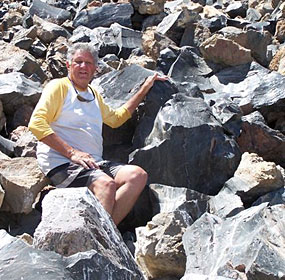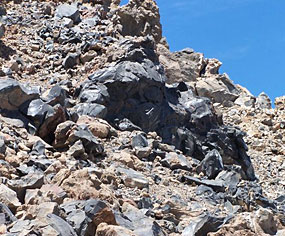This Joe
has Two Volcanoes
The Enchanted Islands emerge from the
Sea of Cortez just off the coastline of Baja between
Puerocitos and Gonzaga Bay. These are small islands
with Isla San Luis reported as being the largest at
less than four square miles. Do not let the size or
the fact that it is named for a Saint fool you because
this island provides a home for two volcanoes. Scientists
believe that this volcano has erupted within the past
500 years. That is a very short period of time for a
volcano, something on the order of a heartbeat.
I have been going to this area for many
years and found that all of the beaches from Puertocitos
south are littered with pumice mostly a very light red
in color but some a light gray. I had read of an annual
pumice release, didn’t much believe the annual
part so I started to search the www and found the information
that I wanted at http://www.asn.csus.edu/reforma/press.htm
Once you begin a web search it is amazing what can be
found and the inane matches can be either frustrating
or amusing. This site details work done by Dr. Brian
Hausback of the University of California Sacramento,
Dr. Hausback has allowed me the use of the information
providing that I give credit. The site also has photos
along with some awesome spectral images taken from satellite.
The photos are copyrighted fortunately I have many of
my own except the ones taken and transmitted from space.
 Current
activity suggests that this volcano is likely building
for another explosion. The active gas vent and the fact
that this island is rising at a rate faster than anything
else in the area point toward a future eruption. The
gas vent is reported to be on the north side of the
island but I don’t know exactly where it is located.
It is rare that an island of this size has two volcanoes
even more astounding they are different types. One is
a cinder cone and the other a lava flow (it suddenly
seems that Lava Soap should be named Pumice Soap). A
telpha ring or cinder cone is formed as the material
that has been exploded from within the earth settles
back to earth. The entire south end of the island is
cinders and that is reported as a massive amount.
Current
activity suggests that this volcano is likely building
for another explosion. The active gas vent and the fact
that this island is rising at a rate faster than anything
else in the area point toward a future eruption. The
gas vent is reported to be on the north side of the
island but I don’t know exactly where it is located.
It is rare that an island of this size has two volcanoes
even more astounding they are different types. One is
a cinder cone and the other a lava flow (it suddenly
seems that Lava Soap should be named Pumice Soap). A
telpha ring or cinder cone is formed as the material
that has been exploded from within the earth settles
back to earth. The entire south end of the island is
cinders and that is reported as a massive amount.
The telpha ring has one side missing and
is named Plaza de Toros. The lava flow has capped the
highest part of the island with a dome of obsidian or
natures glass. One word about obsidian, it cleaves sharper
than man can sharpen anything and Indians native to
North America have been using it for hundreds of years.
A hike up to the obsidian dome will take you through
a rookery of brown pelicans and sea gulls. Let your
imagination run wild about the odor. Arriving at the
flow I see pieces of obsidian much larger than anything
that I have seen in Quartzsite which is billed as the
world’s largest gem and mineral show. Ten miles
from the island I have found many Apache Tears which
are essentially obsidian raindrops
Still searching for the pumice release
and now we know that Isla San Luis has active gas vents;
does pumice come up with some of the gas releases? A
fellow from the US who now lives at Punta Willard has
observed the island calving. I am guessing that he saw
this from shore and that would represent a large amount
of pumice being released into the sea water. Running
through small patches of this with the boat is fun and
it cleans the bottom of the boat. When approaching from
the open side of Plaza de Toros distinct layering is
evident and looks very much like sedimentary layers.
Closer observation reveals that these layers are all
composed of cinders. On the island one can see many
places where the cinders have collapsed leaving near
vertical walls. 
When the new road from Puertocitos to
Gonzaga Bay was being built a very thick layer of black
cinders was exposed between La Castillo and Nacho’s
camp. These are a soft composition and scrape away very
easily, now I believe that Isla San Luis is responsible.
South of Gonzaga there is reported to be large deposits
of cinders again spawned by our small but violent island.
And speaking of violent what happened to the south side
of our cinder cone? A blow out through the side, something
like Mount Saint Helens on a smaller scale could have
taken it away. My guess would be natural erosion from
storms in the Sea of Cortez which would cause intermittent
releases of pumice.
The cinder cone is very likely the more
dangerous of the two volcanoes. The seagulls firmly
believe that they own the Plaza de Toros and they do
not hesitate to show their irritation at your presence.
Once a friend and I started to walk across the lowest
part of Plaza de Toros’ as we approached the center
of the depression our footing became more and more soft.
When we were sinking past our ankles on every step I
succinctly declared “I ain’t going any farther”.
The island is like a magnet it continues
to pull me ashore whenever I get close.
Note: This is the area that host’s
the “Three Terrible Sisters”. The new road
has done a good job of taming the sisters. The old road
was much, much worse and I have a collection bent and
broken suspension parts to offer as proof. Now I ride
my ATV along the old road and reflect on how tough these
hombres really were.